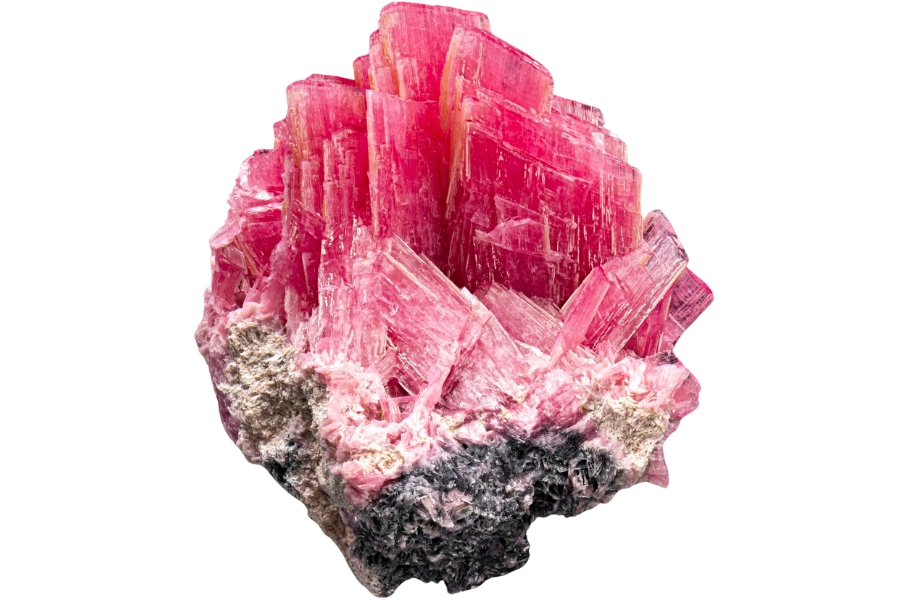Pink gems, crystals, rocks, and minerals are some of the world’s most stunning and sought-after. These beautiful stones are found all over the globe and come in a wide variety of shapes and sizes.
Ancient civilizations have treasured these extraordinary specimens for thousands of years. They are believed to have spiritual and healing properties that can help bring balance to one’s life.
Pink gems, crystals, rocks, and minerals can be used for various purposes. For example, they can be worn as jewelry or kept in a pocket to bring luck or protection from evil spirits.
They can also be placed around the home to create a peaceful atmosphere or used in meditation practice to open up channels of communication with higher realms. On top of that, these gorgeous stones make great gifts for special occasions.
Whether you are looking for a unique piece of jewelry or a special addition to your home decor, you can be sure that pink gems, crystals, rocks, and minerals will bring a unique energy and charm to any space!
Pink Gems and Crystals
Some of the most exquisite and attractive pink gems and crystals include the following:
Morganite – Be3Al2Si6O18
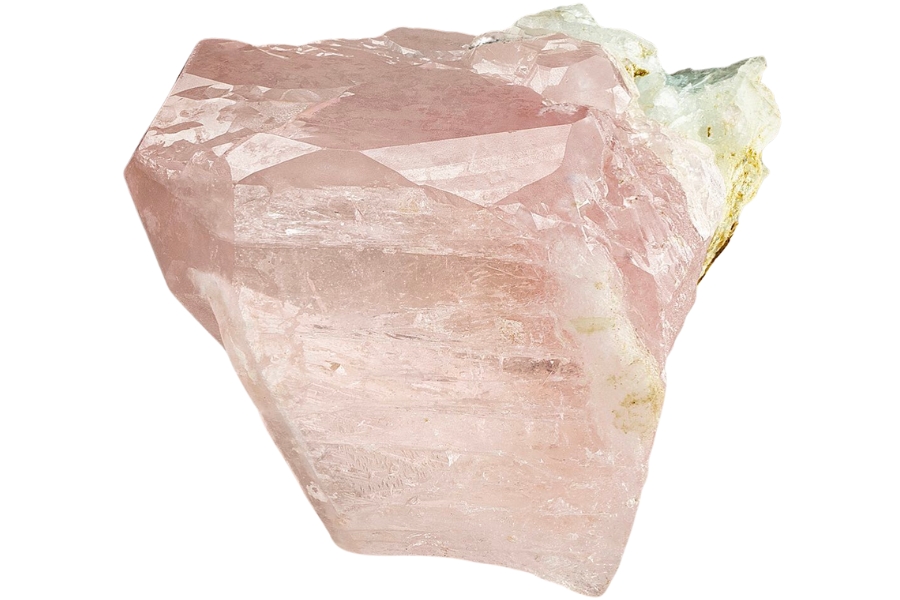
Morganite is a semi-precious gemstone with a beautiful pinkish-peach hue. It’s also known as ‘pink beryl’ due to its pinkish color.
The stone was first discovered in Madagascar during the early 20th century and was named after the famous American financier J.P. Morgan, an avid collector of precious gems.
Morganite is a variety of beryl, one of the most common minerals found on Earth. It has been used for centuries in various forms of jewelry, from necklaces to earrings and bracelets, and it’s highly sought after for its beautiful color and durability.
Today it’s still popularly used in fine jewelry pieces and continues to be admired for its beauty and versatility.
Fun Fact In 1989, one of the largest Morganite specimens was found in Buckfield, Maine's Bennet Quarry. The crystal, known as the "Rose of Maine," weighed more than 50 pounds!
Where Morganites are found
Morganite can be found in many locations worldwide, including Brazil, Afghanistan, Madagascar, Mozambique, Namibia, Nigeria, Pakistan, and the United States (Maine and California).
How you can identify a Morganite
Color
Morganite is a beautiful pinkish-peach gemstone ranging in hue from light to deep salmon. Its soft pastel tones are often accented with a hint of rose or orange, making it a unique and eye-catching gem.
Hardness
Morganite is a relatively soft gemstone, with a hardness of 7.5 to 8 on the Mohs scale.
It’s durable and suitable for everyday wear, though it may require extra care when cleaning or setting in jewelry as it’s slightly more fragile than other stones such as diamonds or rubies.
Clarity
Morganite has excellent clarity and transparency, with inclusions typically visible only under magnification. Its clarity ranges from transparent to translucent, allowing light to pass through the stone easily.
Morganite’s clarity is further enhanced by its vitreous luster and vitreous-to-resinous brilliance.
Refractive index
Morganite is a beryllium aluminum silicate mineral with a refractive index of 1.577–1.583, slightly higher than quartz but lower than diamond.
It has a birefringence of 0.008 and a dispersion of 0.014, making it relatively low compared to other gemstones.
Additionally, its pleochroism is weak to moderate, appearing colorless or pinkish depending on the angle of view and light source.
Specific gravity
Morganite has a specific gravity of 2.71-2.90. This indicates that it’s a relatively dense gemstone, making it ideal for use in jewelry as it won’t quickly become damaged or scratched.
It’s also heavier than many other gemstones, meaning it has better durability and longevity.
Rhodolite – Mg3Al2(SiO4)3
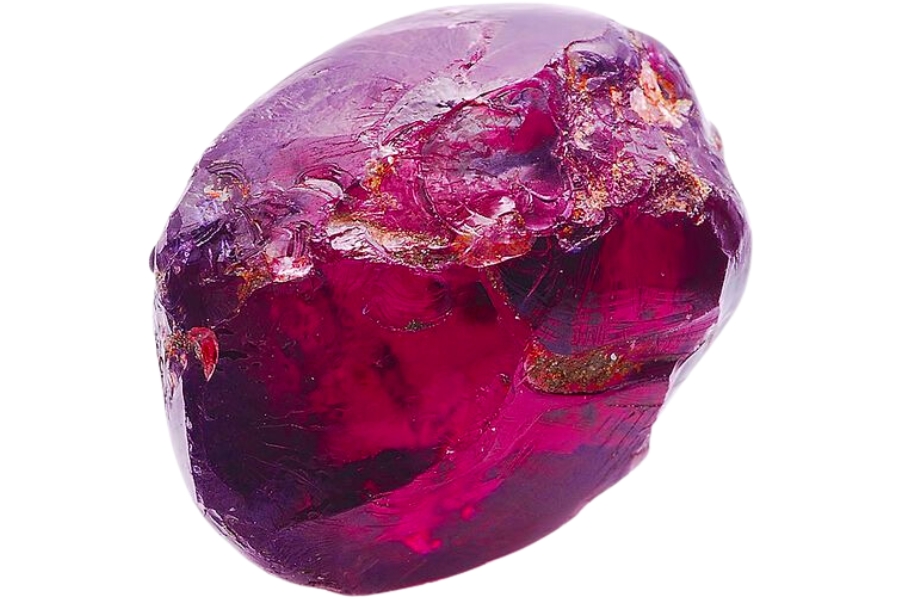
Rhodolite is a beautiful, pinkish-purple variety of the mineral garnet. It is found in many parts of the world, including North America, Brazil, and Sri Lanka. It has been used in jewelry for centuries and was particularly popular during the Victorian era.
Rhodolites are often used as an affordable alternative to rubies and sapphires due to their hardness and brilliance.
It’s also believed to possess healing properties that can help reduce stress, increase energy levels, and protect against negative energies.
In addition to jewelry, rhodolite can be used for carving ornamental items such as beads and figurines.
Fun Fact
Its name originates from the Greek word "rhodon," meaning rose-colored.Where Rhodolites are found
Rhodolites can be found in many locations, including India, Sri Lanka, Brazil, Madagascar, Myanmar (Burma), Tanzania, and the United States.
How you can identify a Rhodolite
Color
Rhodolite is a vibrant pinkish-purple gemstone with a hint of raspberry red. It can range from pale to dark and often has flashes of silver or gold.
Hardness
Rhodolite is a type of garnet that ranges in hardness from 6.5 to 7.5 on the Mohs scale. It’s a relatively hard gemstone, slightly less hard than quartz and corundum but more durable than beryl and feldspar.
Rhodolite is tough enough to withstand everyday wear and tear, making it an excellent choice for rings and other jewelry.
Clarity
Rhodolite is a type of garnet with clarity ranging from transparent to translucent. Inclusions are typical in rhodolite, but they usually don’t affect its beauty too much, and many gemstones with inclusions still have good clarity.
It is also known for its strong luster and its ability to refract light, giving it a sparkle that makes it particularly attractive.
Refractive index
Rhodolite has a refractive index of 1.746 to 1.762, which is higher than quartz’s but lower than a diamond’s. It is also birefringent, meaning it has two different refractive indices depending on the direction of light passing through it.
Specific gravity
The specific gravity of rhodolite is 3.60 to 3.70, which is slightly higher than other garnet varieties like almandine and pyrope.
This difference in density is due to the presence of aluminum silicate and traces of vanadium or chrome, which increases its weight. The higher specific gravity of rhodolite makes it easier for gemologists to identify it amongst other garnets.
Rose Quartz – SiO2
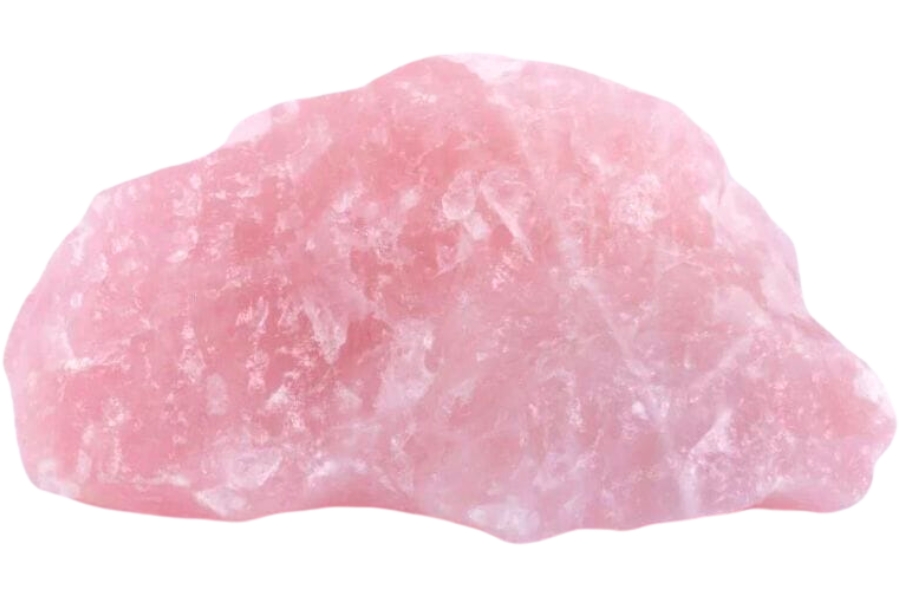
Rose quartz is a variety of quartz known for its distinctive soft pink coloration. It has been used throughout history as a gemstone for jewelry and decorative purposes.
The stone has long been associated with love and beauty, used in amulets and talismans to attract love, friendship, and peace.
Rose quartz was believed to have healing properties, with the Ancient Egyptians using it to protect against negative energy and promote fertility.
Today, rose quartz is still highly valued for its beauty, often used in jewelry or as a decorative feature in homes. It’s also thought to bring peace, harmony, and balance into the lives of those who wear it or keep it close by.
Fun Fact
Rose quartz serves as a substitute gift for the traditional cotton that is given on the second wedding anniversary. If you know someone who is celebrating this anniversary, you can give them rose quartz crystals!Where Rose Quartz is found
Rose quartz is found in Brazil, Madagascar, India, South Africa, and the United States.
How you can identify a Rose Quartz
Color
Rose quartz is a soft, rosy pink hue often described as delicate and romantic. It has a subtle warmth that can range from a light, barely-there pink to a deep blush color.
Hardness
Rose quartz is a relatively soft stone with a Mohs hardness of 7. It’s softer than the average semi-precious stone but hard enough to be used in jewelry and other decorative items.
It can be scratched by harder materials such as quartz, topaz, and corundum, but it is not easily damaged by everyday wear and tear.
Clarity
Rose quartz is a translucent to semi-opaque crystal, ranging from light pink to a deep pink hue. Its clarity varies; some stones may be nearly opaque, while others may display a degree of transparency.
Inclusions such as rutile needles and tiny bubbles can sometimes be seen, adding to its unique character. The clarity of rose quartz can also depend on the size and shape of the stone; larger stones tend to be less transparent than smaller ones.
Refractive index
Rose quartz has a refractive index of 1.544-1.553, making it slightly more optically dense than other quartz varieties. Its birefringence is around 0.009, less than amethyst’s, and its dispersion is 0.013, lower than that of citrine and smoky quartz.
It also has a higher optical clarity than the average for quartz due to its low absorption in the visible light spectrum.
Specific gravity
Rose quartz has a specific gravity of 2.65, slightly higher than the average for quartz (~2.60). This means that it’s slightly denser than other types of quartz, making it heavier for its size.
Its specific gravity also helps to distinguish rose quartz from different types of quartz, such as amethyst and citrine.
Rosolite – Ca3Al2(SiO4)3
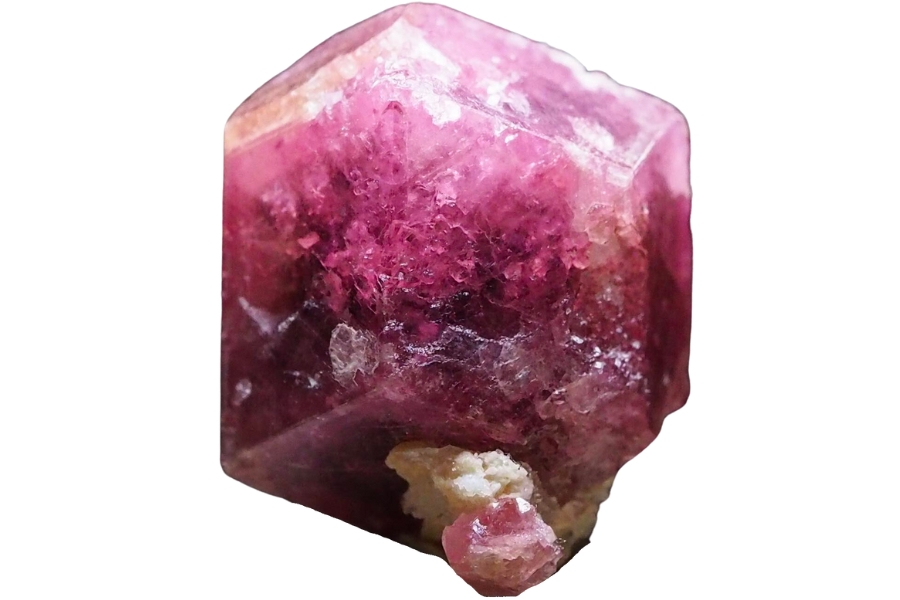
Rosolite is a rare gemstone that has become increasingly popular in recent years. It’s a form of spinel, a mineral composed of magnesium, aluminum, and oxygen.
It has a unique color with an intense red hue and can be found in shades ranging from pink to purple to orange. It’s often used as an accent stone in jewelry, adding a unique sparkle and glamour to any piece.
Rosolite’s rarity makes it highly sought after, and its popularity continues to rise. This attractive gemstone has been valued for its beauty since ancient times, with many cultures believing it had healing properties.
Rosolite’s versatility makes it perfect for any occasion or style of jewelry, making it a great choice for anyone looking for something special.
Fun Fact
Its name was derived from the Greek words "Rosa" meaning "rose," and "Lithos" meaning "stone." Where Rosolites are found
Rosolites can be found in various locations, including Canada, the United States, Mexico, and India. They are also found in multiple gemstone mines and deposits in Europe, South America, and Africa.
How you can identify a Rosolite
Color
Rosolite is a soft pinkish-purple hue with delicate undertones of lavender and rose. Its subtlety lends itself to a gentle and calming atmosphere, perfect for any room needing a soothing atmosphere.
Hardness
Rosolite is a relatively hard gemstone, with a hardness rating of 6.5 to 7 on the Mohs scale. Its hardness makes it suitable for use in jewelry, as it can withstand everyday wear and tear without being easily scratched or damaged.
Clarity
Rosolite has good clarity, with a vitreous luster that gives it a sparkly appearance. It’s translucent to transparent in thin pieces, making it an attractive gemstone.
The inclusions in the stone can be seen when held up to the light, usually as tiny bubbles or needles.
Refractive index
Rosolite has a refractive index of 1.51-1.53, slightly higher than the average for quartz and other minerals in the same family. It is anisotropic, meaning its refractive index varies depending on the direction of light passing through it.
Specific gravity
Rosolite has a specific gravity of 4.2, considered high for a gemstone. It’s much heavier than most other gemstones, making it more difficult to cut and shape into jewelry.
Rubellite – A(D3)G6(T6O18)(BO3)3X3Z
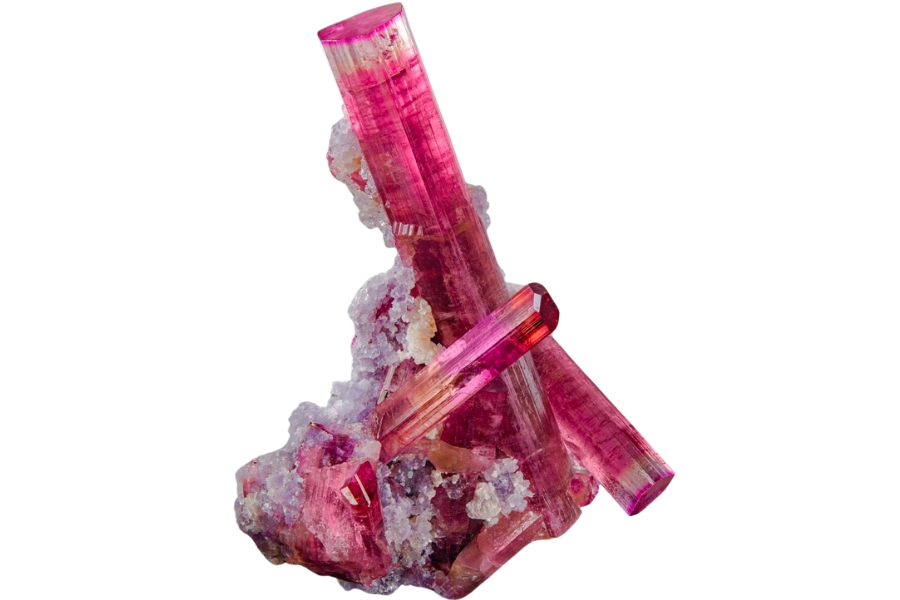
Rubellite is a precious gemstone sought after for centuries for its captivating beauty. It is a variety of the mineral tourmaline, and its name comes from the Latin word ‘rubellus’, which means ‘reddish.’
Rubellite has long been associated with love and passion due to its deep pink or red hues, and it was once believed to have magical powers that could ward off evil spirits.
Ancient civilizations prized rubellite and used it in amulets and other jewelry pieces. In the Middle Ages, it was an important symbol of nobility and wealth, while in more recent times, it has become a popular choice for engagement rings.
Today, rubellite is highly sought after due to its unique beauty and rarity.
Fun Fact
A whopping 100,000 carats of rubellites are mined yearly in different parts of the globe. Where Rubellites are found
Rubellites can be found worldwide, and the top producers are Brazil, Madagascar, Nigeria, and Sri Lanka.
How you can identify a Rubellite
Color
Rubellite is a stunning pink-to-red gemstone with a captivating hue ranging from a light purplish-pink to a deep raspberry red. Its vibrant color is due to its high iron content.
Hardness
Rubellite is usually 7-7.5 on the Mohs scale of mineral hardness. This makes it quite hard compared to many other gemstones but softer than others, such as diamonds.
Clarity
Rubellite exhibits excellent clarity, often appearing transparent to translucent. It has an attractive vitreous luster and is usually free from any inclusions or flaws, making it highly sought after for its eye-catching brilliance.
The clarity of rubellite can range from clean and bright to misty and hazy, depending on the size and orientation of the crystals.
Refractive index
The refractive index of rubellite is quite high, ranging from 1.603 to 1.624, depending on the angle of light entering the stone.
It has a double refraction, meaning that when light enters the stone it’s split into two beams that travel at different speeds and in slightly different directions.
This causes the stone to display a unique play of colors and can create an optically pleasing effect when cut correctly.
Specific gravity
The specific gravity of rubellite is between 3.1 and 3.3, depending on the variety. It’s a fairly dense stone, slightly heavier than quartz but lighter than tourmaline.
Spinel – MgAl2O4
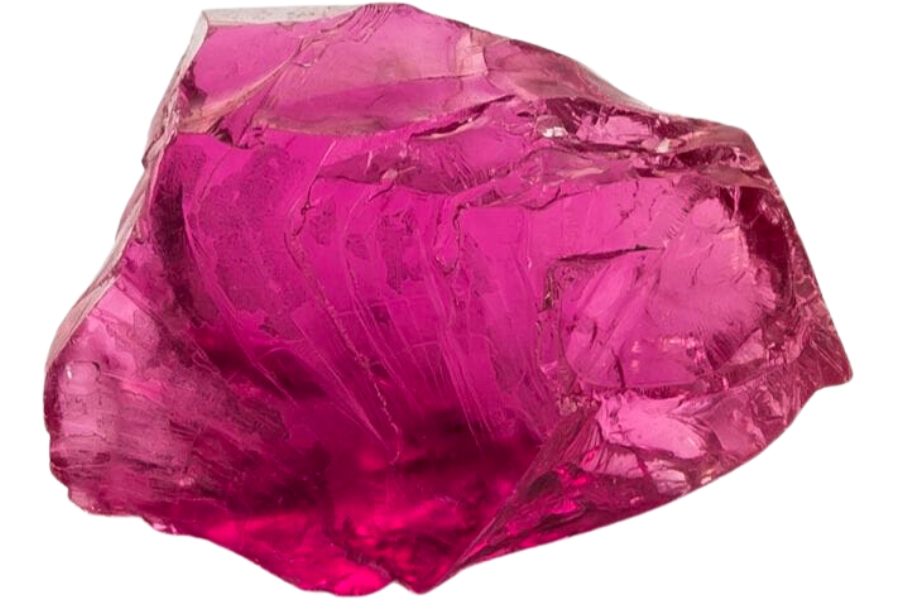
Spinel is a mineral that has been prized since ancient times. It is composed of magnesium aluminum oxide and is known for its exceptional hardness and brilliance.
Its name is derived from the Latin word ‘spina’, meaning ‘thorn’. It was first mentioned in the works of Pliny the Elder in the 1st century AD.
Over time, spinel has been highly sought-after due to its beauty and durability. Today, spinel continues to be an incredibly popular gemstone, with its vivid colors and remarkable hardness making it an excellent choice for jewelry pieces.
Fun Fact
Spinel's unique hue has made it a favorite gemstone among royalty throughout history; it has been found in the crowns of kings and queens as far back as Elizabeth I of England.Where Spinels are found
Spinels have been long mined in Afghanistan, Myanmar, Thailand, Sri Lanka, and Vietnam.
How you can identify a Spinel
Color
Spinel is a gemstone in many colors, from deep red to violet, pink, blue, and black. Its vibrant hues can be enhanced by cutting and polishing the stone. Spinel also comes in shades of yellow, orange, green, gray, and brown.
Hardness
Spinel is a mineral that has a hardness on the Mohs scale of 8, which is considered to be hard. It’s relatively durable and can withstand considerable wear and tear.
It’s hard enough to scratch glass but softer than corundum, the hardest naturally occurring mineral.
Clarity
Spinel has a high level of clarity. It has a glassy appearance and can be transparent or translucent. The stone’s clarity is determined by its number of inclusions and blemishes, with higher-quality stones having fewer inclusions.
Spinel can appear in many colors, and its transparency allows maximum light to pass through it, creating bright flashes of color.
Refractive index
Spinel has a refractive index ranging from 1.7 to 2.2 in the visible light spectrum, depending on the composition of the material.
This relatively high refractive index makes spinel an essential optical material in various applications, such as lenses and prisms.
The birefringence of spinel is also relatively high for a non-crystalline material, making it suitable for polarizing optics.
Specific gravity
Spinel’s specific gravity is 3.6 to 3.8, which is relatively high compared to other gemstones. It’s a dense gemstone with a heavy feel and can be difficult to cut due to its hardness.
Pink Rocks
The following is a list of some of the most amazing pink rocks you can find:
Quartzite – SiO2
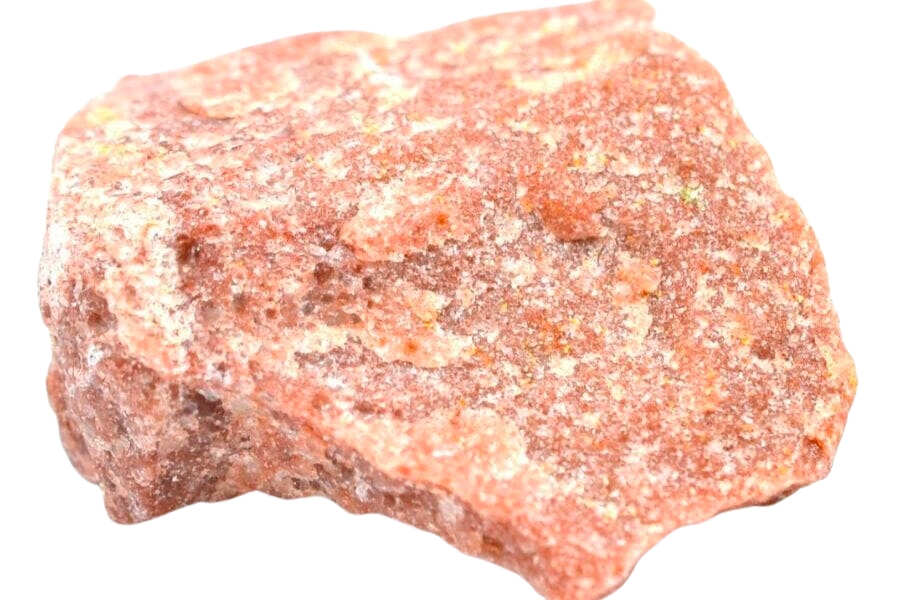
Quartzite is a type of metamorphic rock, formed from sandstone when subjected to extreme heat and pressure. It’s characterized by its interlocking grain structure and its hard, non-foliated surface.
The ancient Egyptians used it in their temples and tombs, while the Romans also employed it for their structures and sculptures.
Quartzite was also popular in the Middle Ages, particularly for cathedrals and churches. In more recent years, it has gained popularity as a decorative material due to its unique coloration and texture.
Its ability to hold up to wear makes it an ideal choice for countertops, flooring, tiles, wall cladding, and more. Today, quartzite remains a popular choice among architects and builders due to its durability and beautiful aesthetic appeal.
Fun Fact
Quartzite is one of the most durable natural stones available and has been used in construction for thousands of years, including as a building material for ancient monuments like Stonehenge.Where Quartzites are found
Quartzites are found in many places, including Canada, the United States, South America, Africa, Europe, Asia, and Australia.
How you can identify a Quartzite
Color
Quartzite is a beautiful, natural stone that is typically greyish-white in color. It can contain veins of pink, yellow, green, and blue, giving it a unique and interesting appearance.
Hardness
Quartzite is a very hard and durable metamorphic rock, with a hardness of 7 on the Mohs scale. It is resistant to weathering, abrasion, and chemical erosion, making it an ideal material for use in construction and landscaping projects.
Its toughness also makes it suitable for use as a building stone, paving material, and decorative aggregate.
Clarity
Quartzite has a crystalline texture and clarity that makes it stand out from other stones, giving it an almost glass-like appearance.
Its natural luster also adds to its beauty and gives it an elegant look that makes it popular for commercial and residential applications.
Refractive index
Quartzite has a refractive index of 1.54-1.55, slightly higher than quartz (1.54). This is due to its high silica content and greater density, which results in quartzite having a higher birefringence than quartz.
The refractive index of quartzite also varies depending on the type of impurities present in it, such as iron or aluminum oxide.
Specific gravity
Quartzite has a specific gravity of 2.65-2.75, making it one of the denser natural rocks. Its density is due to its composition of quartz and feldspar, both very hard and heavy minerals.
Its high specific gravity makes it highly resistant to weathering, making it an ideal material for construction projects where durability is essential.
Pink Minerals
Here’s a good collection of some of the most stunning pink minerals that exist:
Albite – Na(AlSi3O8)
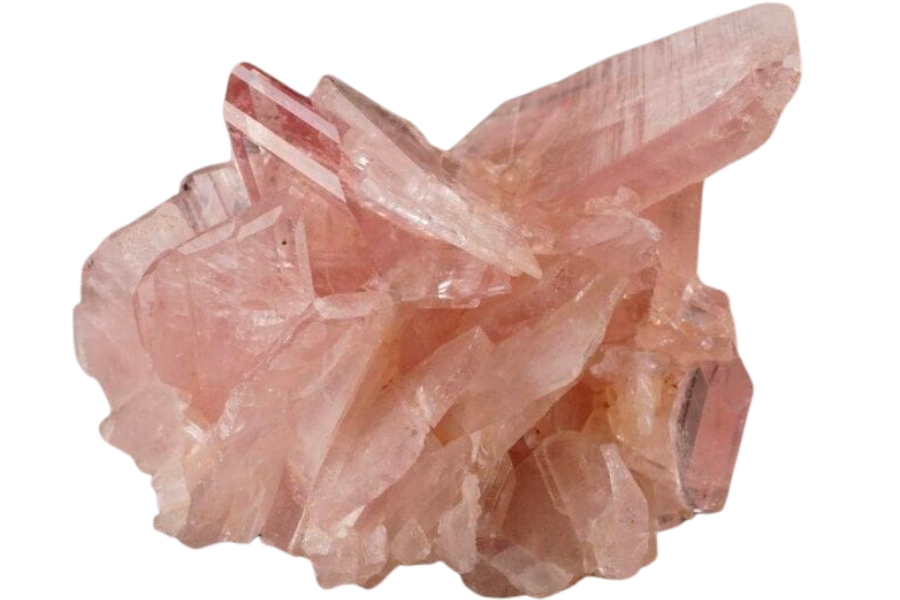
Albite is a feldspar mineral, one of the most abundant minerals in the Earth’s crust. It forms from the cooling and crystallization of magma or lava and can be found in many rocks, such as granite and pegmatite.
Albite has a white to grayish or bluish-green color and a vitreous to pearly luster. It was first described in 1789 by Abraham Gottlob Werner and named for its alabaster-like appearance.
Albite usually occurs as tiny, blocky crystals but can also form as large masses up to several feet across. Its cleavage is perfect in two directions at 90° angles and has a conchoidal fracture.
In addition to being found in igneous rocks, albite can also be found in hydrothermal veins, sedimentary rocks, and metamorphic rocks. It’s used mainly for ornamental stone, ceramic glazes, glass making, abrasives, and filler.
Fun Fact When an albite is hit with a hammer, it will break into smooth planes that form perfect cubes. What a unique ability!
Where Albites are found
Albites can be found in many places around the world, including Canada, the United States, Germany, Italy, France, and Austria. They are also found in some parts of Africa and Asia.
How you can identify an Albite
Color
Albite is a light-colored mineral with a delicate white and pink shade. It’s often used in jewelry and decorative items because of its gentle hue.
Hardness
Albite is a mineral with a hardness of 6 on the Mohs scale. It’s a relatively soft mineral, slightly harder than talc but softer than calcite.
As such, it can be scratched with a knife and leave powdery white streaks when rubbed against unglazed porcelain.
Clarity
Albite has excellent clarity and transparency, with a vitreous luster and a pearly sheen. Its crystal structure is transparent enough to allow light to pass, making it an ideal stone for jewelry and decoration.
Albite’s transparency also makes it desirable for optical instruments like microscopes and telescopes.
Refractive index
Albite has an average refractive index of 1.524-1.527 for the visible light spectrum, ranging from slightly lower (1.525) in the violet to slightly higher (1.527) in the red.
Its birefringence is low at 0.001-0.002, and its dispersion is moderate at 0.014, making it a suitable material for optical applications such as lens making and gemstone cutting.
Specific gravity
The specific gravity of albite is 2.62, slightly higher than the average for silicate minerals. This indicates that it has a relatively high density compared to other minerals and is dense enough to be used as a gemstone.
Its specific gravity can also be used in identification tests for albite or other minerals to differentiate them from one another.
Cobaltoan Calcite – (Ca,Co)CO3
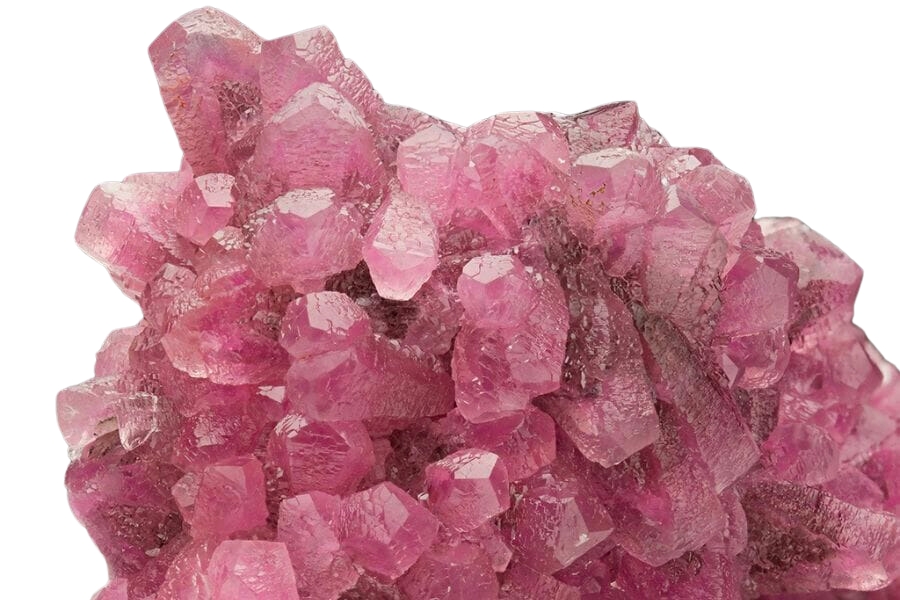
Cobaltoan calcite is a type of calcite mineral that contains cobalt ions, giving it its unique pink-to-red color. It’s a relatively rare mineral that has been known for centuries.
It was first discovered in the 18th century in the Czech Republic, where it was mined from the quarries of Kutna Hora.
Cobaltoan calcite has been used throughout history for decorative and ornamental purposes, including jewelry and sculptures. Its intense color makes it an attractive gemstone, and its popularity continues to grow today.
It’s often used as a healing stone due to its vibrational energy and ability to balance emotions.
Fun Fact
Cobaltoan calcite has a unique energy that can help to open and heal the heart chakra, allowing one to give and receive love more easily.Where Cobaltoan calcites are found
Cobaltoan calcite can be found in various parts of the world, including Mexico, Congo, Australia, Morocco, the UK, Spain, Italy, and Switzerland.
How you can identify a Cobaltoan calcite
Color
Cobaltoan calcite is a deep and vivid pink to rose-red color. Its high transparency enhances its hue, and the stone can have a range of shades from light pink to dark magenta.
Hardness
Cobaltoan calcite is a relatively soft mineral with a Mohs hardness of 3.5 to 4. Its softness is due to the calcium carbonate content in its chemical structure, which makes it easily scratched by harder materials such as quartz and feldspar.
Clarity
Cobaltoan calcite is a type of calcite mineral that has a vitreous to pearly luster and transparent to translucent clarity.
Refractive index
Cobaltoan calcite has a refractive index of 1.658 and an average birefringence of 0.055, which is lower than most other calcites.
This makes it optically less active than other types of calcite, and it can be used to make optical components with low birefringence for applications such as laser optics.
Specific gravity
Cobaltoan calcite has a specific gravity of 3.0-3.03, slightly heavier than quartz and gypsum. This mineral is also heavier than other rocks, such as granite and sandstone.
The high specific gravity of cobaltoan calcite makes it ideal for certain applications, such as its use in the production of decorative items and jewelry.
Eudialyte – Na15Ca6Fe3Zr3Si(Si25O73)(O,OH,H2O)3(Cl,OH)2
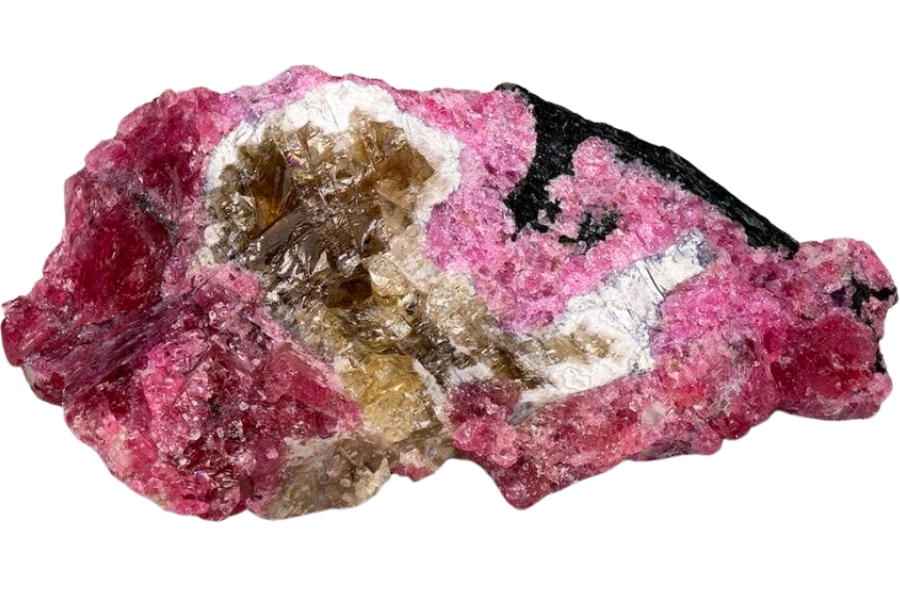
Eudialyte is a rare mineral composed of sodium, calcium, iron, manganese, silicon, and hydroxide. It’s found in alkaline igneous rocks and can be identified by its deep pink-to-red color.
It was first discovered in 1819 near the Eudialyte River in the Kola Peninsula, Russia (hence its name).
It’s prized for its unique beauty and metaphysical properties as it is believed to help one connect with his or her higher self and promote spiritual growth.
Eudialyte is also used in jewelry and ornamental pieces due to its striking colors. Its rarity makes it a desirable item for collectors of unusual stones.
Fun Fact
Eudialyte restores energy levels and boosts vitality. If you're exhausted or recovering from a minor illness, it can provide comfort and strength to keep you going. Where Eudialytes are found
Eudialyte has since been found in Greenland, Canada, Norway, and the United States.
How you can identify a Eudialyte
Color
Eudialyte is a striking, colorful mineral. Its base coloration is red, ranging from light to dark shades of pink and rose. It can also display shades of yellow, orange, brown, violet, and white.
Eudialyte often has black or dark green patches and streaks, as well as tiny flecks of black or white throughout the stone. The vibrant colors make it an attractive choice for jewelry and ornamental objects.
Hardness
Eudialyte is a relatively hard mineral, with a Mohs hardness of 5.5-6. It has good cleavage and is brittle, with a vitreous luster and slightly greasy feel. It can be scratched by a knife and powdered by hammering or by grinding with sandpaper.
Its conchoidal fracture and uneven fracture surfaces make it difficult to shape. However, it can be polished to a glassy finish.
Clarity
Eudialyte is a rare mineral that exhibits excellent clarity. It typically appears as a deep red color with a vitreous luster, and its transparency allows light to pass through it quickly.
Refractive index
Eudialyte has a refractive index that varies with wavelength, ranging from 1.721 to 1.844 in the visible spectrum. Its birefringence is also quite high, ranging from 0.105 to 0.189, indicating a high degree of anisotropy in its structure.
In addition, eudialyte exhibits dispersion, with its refractive index increasing as the wavelength decreases.
Specific gravity
Eudialyte is approximately 3.2-3.4, higher than most other minerals. Its density is due to its high content of rare earth elements and minerals such as zirconium, niobium, and calcium.
Eudialyte is one of the densest minerals known to exist naturally on Earth, and it has an unusual chemical composition that contributes to its high specific gravity.
Pezzottaite – Cs(Be2Li)Al2(Si6O18)
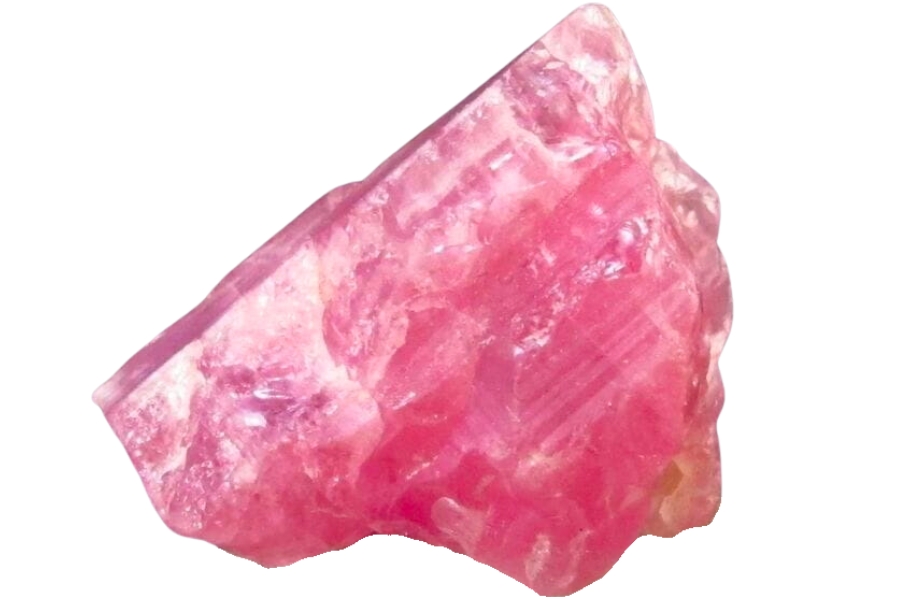
Pezzottaite is a rare gemstone that was first discovered in Madagascar in 2001. It’s a mineral composed of beryllium, manganese, and cesium, and it forms in tiny granular masses or as individual grains.
The stone is intensely pinkish-red and displays a unique asterism when cut as a cabochon.
Pezzottaite has been used to make jewelry since its discovery, but it’s still relatively unknown compared to more common gemstones.
It’s often confused with rhodolite garnet due to its similar color, but pezzottaite’s asterism sets it apart from other stones. Its rarity makes it an attractive choice for collectors and jewelers alike.
Fun Fact The name pezzottaite was given to the gemstone after a prominent Italian mineralogist, Federico Pezzotta.
Where Pezzottaites are found
Pezzottaite can be found in Mozambique, Afghanistan, India, and Russia.
How you can identify a Pezzottaite
Color
Pezzottaite is a mineral with a vivid and captivating color. It has a beautiful raspberry-pink hue, often with flashes of orange or yellow, and sometimes even hints of purple.
Its unique coloring makes it highly sought after by gem collectors and jewelry makers.
Hardness
Pezzottaite is a rare gemstone with a hardness rating of 6.5 to 7 on the Mohs scale, making it slightly softer than quartz and harder than talc. It’s considered suitable for use in jewelry, as it can withstand everyday wear and tear.
Clarity
Pezzottaite is a rare gemstone with excellent clarity. It has a vitreous luster, which gives it an attractive sparkle and makes it suitable for use in jewelry.
The clarity of pezzottaite is usually very good, with no visible inclusions or blemishes, although some specimens may contain internal fractures.
Refractive index
Pezzottaite has a refractive index of between 1.631 and 1.641, which is considered quite high compared to other gemstones. This gives the stone a high brilliance and sparkle, as well as excellent light dispersion and clarity.
The high refractive index allows pezzottaite to reflect more light than many other gemstones, resulting in a brilliant display of color and fire.
Specific gravity
Pezzottaite is a rare gemstone with a specific gravity of 3.50-3.57, slightly higher than quartz but lower than beryl and spinel. This means pezzottaite is relatively dense compared to other gemstones and will sink in water.
Rhodochrosite – MnCO3
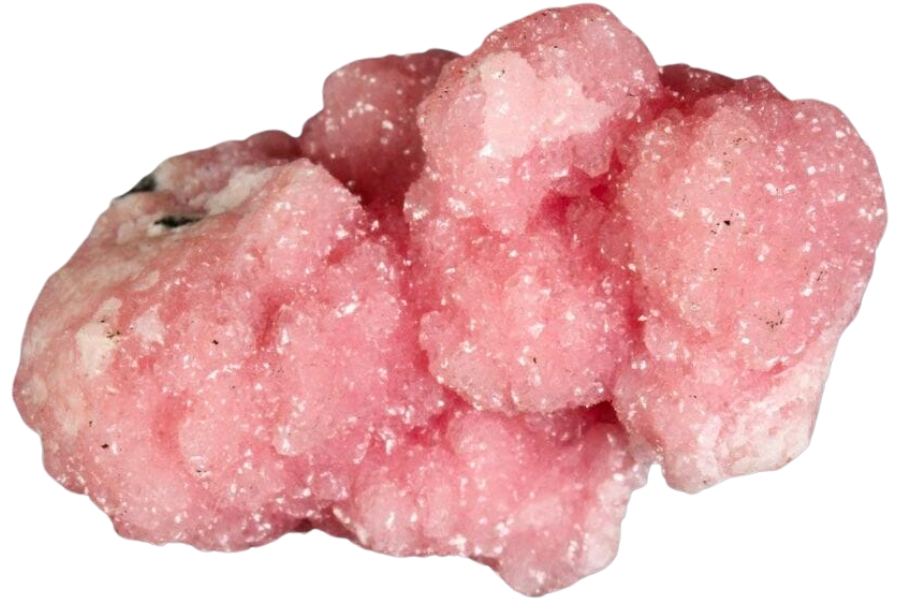
Rhodochrosite is a striking and beautiful mineral known for its deep pink or red color. It’s composed of manganese carbonate and has been used as an ornamental stone since ancient times.
Rhodochrosite was first discovered in the 13th century in Romania, but it was not until the 19th century that it began to be widely appreciated.
The name “rhodochrosite” is derived from the Greek word for rose-colored due to its unique hue.
It’s often used to make jewelry and other decorative items due to its beauty and durability. Its healing properties also bring emotional balance and harmony into one’s life.
Fun Fact
Rhodochrosite is the official state mineral of Colorado.Where Rhodochrosites are found
Rhodochrosite has since been mined in Argentina, South Africa, Peru, and other countries worldwide.
It’s easy to confuse rhodochrosite with other rocks and minerals, but we’ve got you covered. Check out our comprehensive guides below to confirm if what you have is indeed rhodochrosite:
How you can identify a Rhodochrosite
Color
Rhodochrosite is a vibrant and beautiful mineral that ranges from a deep, cherry-red hue to lighter shades of pink and orange.
Hardness
Rhodochrosite is a relatively soft mineral with a Mohs hardness of 3.5-4. It is one of the softer minerals, easily scratched by a knife or other hard objects.
On the Mohs scale, it’s slightly harder than calcite and talc but softer than fluorite and apatite. Rhodochrosite is a fairly brittle mineral, breaking with conchoidal fracture surfaces.
Clarity
Rhodochrosite is a fairly clear gemstone, with a vitreous to pearly luster. It typically appears translucent, though it can also be opaque.
Refractive index
Rhodochrosite has a refractive index of 1.817-1.822, with a birefringence of 0.005-0.006, making it relatively low compared to other gemstones. Its dispersion is also low, at 0.017.
Specific gravity
The specific gravity of rhodochrosite is typically between 3.5-3.7, making it one of the heavier minerals. This is because it’s a carbonate mineral composed mainly of manganese and calcium ions.
Its high density makes it difficult to float in water, but it’s still light enough for lapidary work such as cabochons and carvings.
Rhodonite – CaMn3Mn(Si5O15)
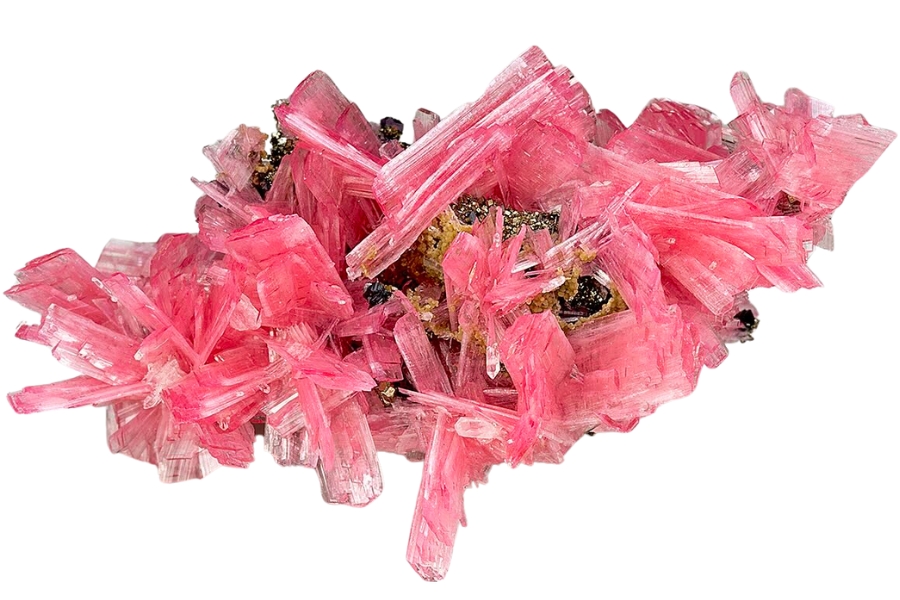
Rhodonite is an attractive and unusual mineral composed of manganese, iron, and silicate. It’s found in many parts of the world but is most abundant in Russia and South America.
Its history dates back to ancient times when it was used as a gemstone in Greece and Rome. Rhodonite was also popular among the Aztecs, who believed it had healing powers.
Recently, it has been used for ornamental carvings, jewelry making, and even as an industrial abrasive material. It has also become a popular material for metaphysical healing due to its calming energy and ability to help one find emotional balance.
Fun Fact The Incas, who called it Inca Rose, thought it contained the blood of their former kings and queens that had been turned into stone. We're (not) looking at you, Medusa!
Where Rhodonites are found
Germany, Sweden, Russia, Spain, Brazil, Mexico, Madagascar, South Africa, India, Australia, Canada, and the United States are just a few countries where Rhodonites may be found.
If you’re not entirely certain that what you’ve discovered is rhodonite, don’t worry. Our guides are here to provide you with the knowledge and confidence to accurately identify rhodonite from other rocks and minerals.
How you can identify a Rhodonite
Color
Rhodonite is a pinkish-red to brownish-black gemstone with subtle black veins that add depth and dimension to its unique color. It also has streaks of white and yellow, which give it a marbled, earthy look.
Hardness
Rhodonite is considered a relatively soft mineral, with a hardness of 5.5 to 6.5 on the Mohs scale. It’s notably softer than quartz and many other common minerals, making it somewhat challenging to work with for jewelry and carving purposes.
Clarity
Rhodonite typically has good clarity, meaning inclusions are minimal. It also exhibits a vitreous luster, a glassy shine reflecting light from its surface. Its transparency makes it ideal for cutting into cabochons or faceted gems for jewelry purposes.
Refractive index
Rhodonite has a refractive index of 1.68-1.72, slightly higher than most other minerals. It exhibits a birefringence of 0.04, meaning that the light entering the mineral is split into two rays, each traveling with a different velocity and direction.
Specific gravity
Rhodonite has a specific gravity of 3.4-3.7, making it relatively dense compared to other minerals. Its density is due to its high iron content and other component elements such as magnesium, manganese, and calcium.
It’s a bit heavier than quartz and feldspar but lighter than hematite or magnetite.
Serandite – NaMn2+2Si3O8(OH)
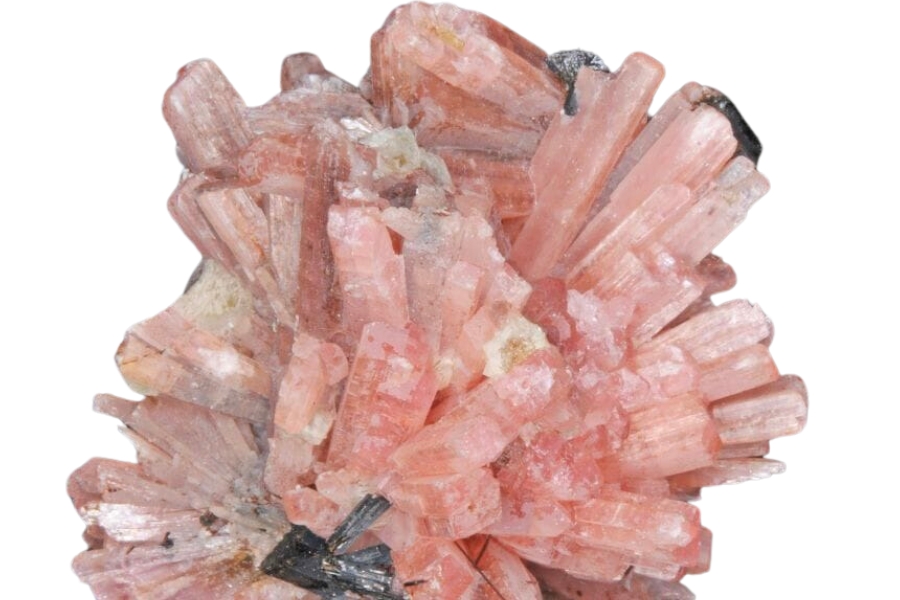
Serandite is an uncommon mineral with a unique pinkish-red color, found in miarolitic cavities of alkaline granites.
It was first discovered in 1892 by the French mineralogist Auguste Leconte and named after the Serandite Hill in Quebec, Canada, where it was initially found.
It contains sodium, calcium, and manganese silicate with titanium, iron, and aluminum traces. Its crystalline structure consists of prismatic crystals that form radiating groups or clusters. Serandites are used as ornamental stones for jewelry.
Fun Fact
Serandite has been found in some of the oldest rocks on Earth, dating back to more than 3 billion years ago.Where Serandites are found
Serandite is usually found in Canada, Madagascar, Russia, and Mexico.
How you can identify a Serandite
Color
Serandite is a beautiful, rare mineral that exhibits a range of colors. It’s usually pink to reddish-brown, sometimes with hints of yellow or green. Sometimes, it can also be grayish or black; some specimens may have a purplish tint.
Hardness
Serandite is a relatively soft mineral with a Mohs hardness of 4-4.5. It’s softer than most gemstones and will scratch easily, so it should be handled carefully.
Although it’s softer than many other minerals, it can still be used in jewelry as long as it is protected from abrasion or damage.
Clarity
Serandite is generally considered to be a gemstone of exceptional clarity. It typically exhibits a glassy luster with no visible inclusions or flaws under magnification.
As such, it can produce exceptionally crisp and vivid reflections when cut and polished correctly, making it an excellent choice for jewelry that requires a high degree of visual brilliance.
Refractive index
Serandite has an average refractive index of 1.717 with a birefringence of 0.076. It exhibits strong pleochroism, appearing yellowish-brown in one direction, and purple-red in the other.
It also displays anomalous double refraction and is transparent to opaque with a vitreous to greasy luster.
Specific gravity
The specific gravity of serandite is 3.2 to 3.3, which is relatively high compared to other minerals.
This indicates that it has a greater density than most other minerals, making it heavier than most others in its class. This also means it will sink in water unless the mineral is incredibly porous or contains many air pockets.
Tugtupite – Na4BeAlSi4O12Cl
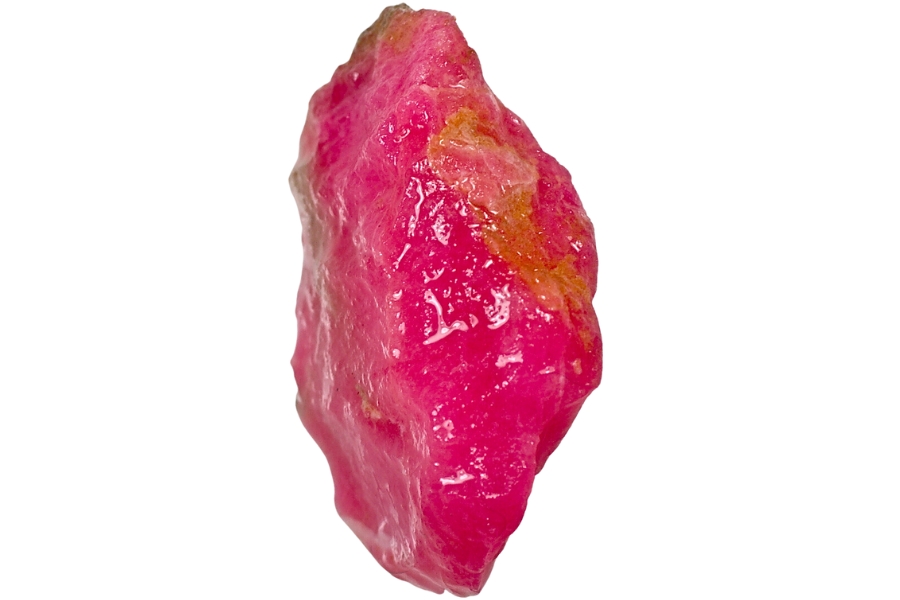
Tugtupite is a rare mineral found in Greenland and the Kola Peninsula of Russia. It was first discovered in 1962 by the Greenlandic geologist Eigil Knuth at the Tugtup Agtakôrfia mountain range.
The mineral has a unique pink-to-red color and can sometimes contain additional shades of yellow or green. It’s composed of sodium aluminum silicate and is often found with other minerals such as quartz and feldspar.
Its name comes from the Inuit words “Tuktu” meaning reindeer, and “pite” meaning stone, due to its resemblance to the reindeer antlers.
Despite its rarity, tugtupite has become increasingly popular recently due to its unique coloration and interesting history.
Fun Fact
In Greenlandic Inuit, "tugtup" is a word that means "reindeer." The nickname has been strengthened by the gem's resemblance to the nose of a reindeer we all know.Where Tugtupites are found
Tugtupites can be found in Greenland and some areas of Canada.
How you can identify a Tugtupite
Color
Tugtupite is a rare mineral with a unique and beautiful range of colors. Its color can appear pink, magenta, red, white, yellow, and even greenish blue.
Hardness
Tugtupite is a rare mineral with a hardness of 5 to 6 on the Mohs scale. This hardness makes it softer than most common minerals but still hard enough to be used as an ornamental stone in jewelry and other decorative items.
Clarity
Tugtupite is a rare and unusual mineral with unique clarity. It’s typically transparent to translucent and can appear almost glassy in quality. It’s known for its strong luster and sparkle, which can be quite eye-catching. Tugtup
Refractive index
Tugtupite has a refractive index of 1.62, making it slightly higher than quartz but lower than topaz or beryl. This high index gives it a higher level of light dispersion, which helps create its characteristic fire and brilliance when cut and polished.
Specific gravity
Tugtupite has a specific gravity of 2.7-3.0, which is relatively high compared to other minerals. It’s heavier than quartz but lighter than galena and hematite, making it an intermediate-weight mineral.
Väyrynenite – BeMn2+(PO4)(OH)
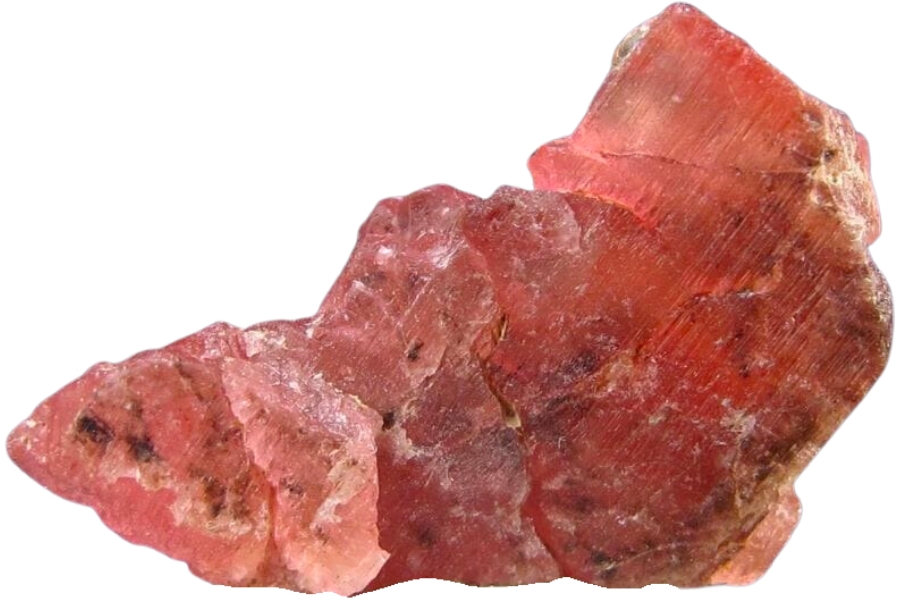
Väyrynenite is a rare mineral found in Finland. It was named after Finnish geologist Heikki Allen Väyrynen. Väyrynenite has an isometric-hexoctahedral crystal structure and forms as prismatic crystals with a vitreous luster.
It’s also a gemstone for jewelry because of its unique color and durability. In recent years it has become increasingly popular among collectors due to its scarcity and beauty.
Fun Fact
Väyrynenites are still quite rare even after its recent discovery. These minerals typically weigh less than 0.5 carats. Where Väyrynenites are found
Väyrynenite has been found in several locations worldwide, including Finland, Russia, Norway, and Madagascar, but its most abundant source is Finland’s Outokumpu deposit.
How you can identify a Väyrynenite
Color
Väyrynenite is a rare mineral with a unique coloration. It ranges from pale yellow-brown to dark brown, often with shades of pink or green. Its hue is due to its copper content and it often displays an iridescent quality when exposed to light.
Hardness
Väyrynenite is considered a hard mineral, with a Mohs hardness of 6 to 6.5. It’s harder than glass but softer than quartz, and its hardness can vary depending on the direction in which it’s scratched.
Clarity
Väyrynenite is a gemstone that exhibits a high degree of clarity. It’s known for its transparent and glass-like appearance, as well as its superior refractive index.
This makes it highly sought after for its ability to disperse light and create beautiful optical effects.
Refractive index
Väyrynenite is a mineral composed of calcium, titanium, and iron with a refractive index of 1.841-1.862. It has a birefringence of 0.009 and an optical character that is doubly refracting (optically anisotropic).
Specific gravity
Väyrynenite is a very rare mineral with an average specific gravity of 3.45, higher than most other minerals.
It has a unique combination of high density and low hardness, making it ideal for studying the structure and composition of the Earth’s mantle.

